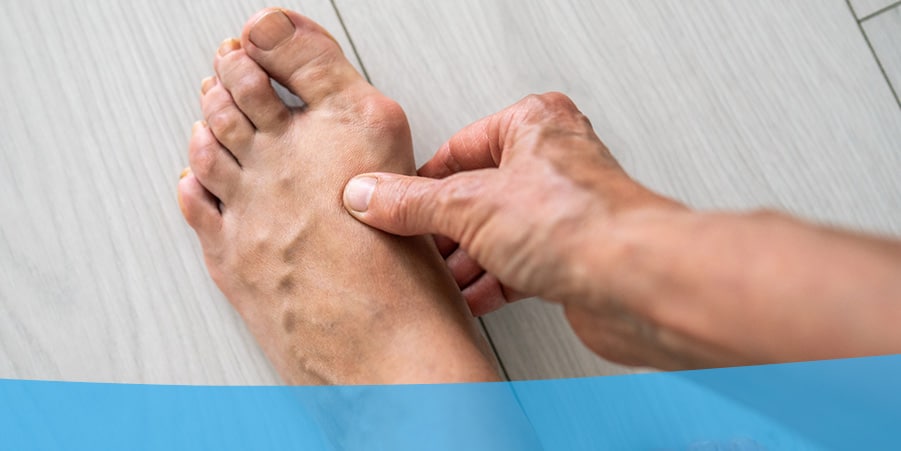Lapiplasty is a type of bunion surgery that addresses the root cause of the bunion. It corrects bunion misalignment in three dimensions, straightening the toe and eliminating the bump. Unlike traditional bunion surgery, which only focuses on removing the visible bump, lapiplasty focuses on restoring the natural alignment of the foot so that the bunion doesn’t come back.
Read on to discover the causes of bunions, how a lapiplasty works and the benefits of receiving this type of surgery.
What Causes Bunions?
Bunions are a type of foot deformity that can be caused by genetics, improperly fitting shoes or an abnormal gait that strains the big toe joint. The condition causes the bone of the big toe to turn toward the others, forming a bump on the inside of the foot. Bunions usually develop and progress gradually over time, typically starting small and developing into a larger deformity if left untreated.
It can become inflamed and irritated and may rub against your shoes, causing pressure and pain. Over time, the bone misalignment can make it harder to move the toes or walk.
How to Treat Bunions
Traditionally, a podiatrist might recommend orthotics or bunion splints at the first sign of a bunion forming. They work by putting the foot in a better position and slowing the bunion’s progression. There are also treatments that can ease the pain, like heat and massage therapy or over-the-counter pain relievers and anti-inflammatories.
If you have a more significant bump or pain that limits your mobility, surgery is an option you can explore with your doctor.
Does a Lapiplasty Work for Bunions?
Lapiplasty surgery corrects bunions by returning the metatarsal bone to its proper position, aligning the foot and removing the bump. It differs from traditional bunion surgery, which often focuses on shaving off the bony bump caused by the bunion or shifting the bone. Traditional surgery doesn’t usually fix the unstable joint at the base of the big toe, making lapiplasty a more permanent solution.
Here’s how lapiplasty works:
- Incision: A small incision is made, and the tarsometatarsal is located.
- Correction: Using a specialized instrument, surgeons guide the bone rotation and fix it to the corrected position.
- Titanium plates: Low-profile titanium plates are applied to the area to stabilize it and secure the corrected position.
- Closure: The incision is closed, and a sterile dressing or bandage is applied.
Most patients can bear weight and walk in a boot within days of surgery. Recovery usually involves physical therapy and a slow transition to normal footwear.
Benefits of Lapiplasty for Bunion Pain Relief
Lapiplasty can bring immediate and long-term bunion pain relief by addressing the underlying cause. The approach offers lasting results and a quicker return to your daily activities:
Lasting Results
Lapiplasty surgeons stabilize the joint of the big toe in three planes — vertically, sideways and rotationally — before administering any cuts. This makes it a more precise, lasting correction than traditional bunion surgeries. The procedure addresses the cause of the deformity, which is the unstable joint and secures it with titanium plates and screws. Rather than simply shaving off the bump, lapiplasty corrects the anatomical problems for better long-term results.
Reduced Reoccurrence Risk
By addressing the underlying problem of instability, lapiplasty also minimizes the chances that the bunion will return. The surgery offers a much more stable correction, keeping the bones from shifting back to their original position. This can give you peace of mind that your bunion will be taken care of the first time, so you can enjoy your return to normal activities with confidence.
Faster Recovery
Unlike traditional bunion surgery, which usually takes six to eight weeks to fully recover, lapiplasty lets you wear a surgical boot and place weight on it within a few days of surgery. The procedure usually requires only small incisions, meaning less tissue trauma and pain, so you can appreciate a faster recovery. It also focuses on repairing and securing the joint so you can return to your normal routine sooner after surgery.
More Comfort
Many patients who receive lapiplasty report better balance and the ability to return to previously painful physical activities. By restoring the foot’s natural alignment, lapiplasty can alleviate most of the pain and discomfort associated with bunions, helping the foot function better overall.
Recovery, Post-Surgery Care and Long-Term Outcomes
In the first few days after a lapiplasty, you can expect some pain, swelling and bruising. You can manage pain with medication, ice and by keeping your foot elevated and dry. After a week or so, stitches can be removed, and you can transition to a walking boot with gentle weight-bearing within three weeks. After about a month, you can walk in the boot and transition to comfortable shoes, returning to light activities and sedentary jobs.
Most people return to their normal daily activities between two and six months after surgery. While individual results can vary, long-term results are generally positive, with most patients having better foot function and less pain.
Is Lapiplasty Right for Everyone?
Consult with a qualified surgeon to see if lapiplasty is right for you. Podiatrists will assess your bunion and medical history and discuss potential risks and benefits. You should also consider your lifestyle, activity level and expectations for the surgery. In some cases, you might be able to try conservative treatments for your bunion before considering surgery.
Why Choose Foot & Ankle Surgical Associates?
At Foot & Ankle Surgical Associates, our team might recommend lapiplasty if you don’t find relief from nonsurgical options or have trouble walking due to pain. When you choose our board-certified foot and ankle surgeons for this procedure, you can rest assured that you’re in good hands. Our team is constantly learning and mastering the newest techniques to give our patients high-quality surgical care.
We also provide the broadest range of conservative treatments and preventive care options, from in-office physical therapy and massage to custom orthotics to help with any foot problems you might be experiencing. Our goal is to provide the best care possible so you can find relief and get back to your everyday routine as soon as possible.
Turn to Foot & Ankle Surgical Associates for Bunion Treatment and Relief
If bunions are holding you back from the things you love, lapiplasty might be right for you. This surgery will correct the root cause of the bunion, offering relief and removing the bump so you can return to the activities you love. Foot & Ankle Surgical Associates offers a range of bunion treatments that can deliver lasting relief, including lapiplasty.
Enjoy a faster recovery, reduced reoccurrence risk and more comfort. Contact us today to schedule a consultation and see if lapiplasty is right for you.
Linked sources:
- https://fasafw.com/podiatry/bunion-doctors/
- https://www.sciencedirect.com/science/article/pii/S1067251621001769
- https://fasafw.com/blog/lapiplasty-versus-other-methods-of-bunion-treatment/#article
- https://www.jfas.org/article/S1067-2516(22)00212-5/abstract
- https://fasafw.com/blog/is-it-finally-time-for-foot-surgery/
- https://fasafw.com/about/podiatry-team/
- https://fasafw.com/#email-form




